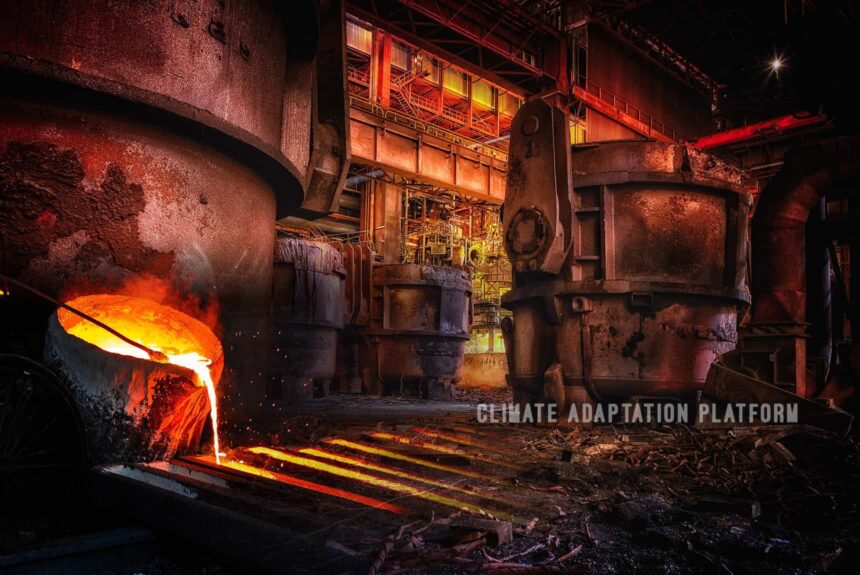Steel is often called the backbone of modern industry.
Everything around us, especially the structures and infrastructures we rely upon for our modern existence, is made of steel and iron. Our tools and machinery are also made from these materials as well as our cars, trucks, trains, and ships.
But steel making remains carbon-intensive. For each ton of steel manufactured, the carbon emitted is almost twice or 1.6 to 2.0 tonnes of CO2 per ton of crude steel produced using the traditional Blast Furnace-Basic Oxygen Furnace production.
The share of the steel industry emissions is around 5% in the European Union and 7% globally. Steel manufacturers are increasingly changing to hydrogen-based steelmaking to decarbonise the industry. The EU aims to develop and scale new low-emissions technologies within the next five to ten years to meet their climate targets (EU climate targets, 2022).
Cleaner ways that steelmakers are exploring to manufacture steel is replacing coke with hydrogen as the reagent – which removes scrubs oxygen from the iron-oxide ore. However, this technology is still considered in its nascent stage.
According to The Economist, Birmingham University’s Professor Yulong Ding and Dr Harriet Kildahl have found a solution that could slash steelmaking emissions by 90%.
Drs Ding and Kildahl used perovskite materials to adapt the design of steel and iron furnaces, slashing carbon emissions by nearly 90%. The dramatic decrease in emission is achieved by applying a ‘closed loop’ carbon recycling system, which could replace almost all the metallurgical coke used in a typical blast furnace-basic oxygen furnace system and produces oxygen as a byproduct.
The duo claimed that the process can also be fitted quickly and cheaply to existing plants, which could be a game changer for the industry that only now struggles to decarbonise.
Steelmakers are getting excited about this and asking whether a demonstration version could be up and running within five years.
The article explains the process that Drs Ding and Kildahl are proposing using the closed-loop carbon recycling system:
“The modification Drs Ding and Kildahl propose (see diagram) cuts coke out of the loop by pumping CO directly into the blast furnace. The clever bit is where this gas comes from. It is made by capturing the CO2 produced in the furnace and recycling it by splitting it into CO and oxygen. The oxygen thus released can then be used in the second part of the steelmaking process, in which that gas is blown through molten iron in a differently designed furnace to burn off part of the carbon now dissolved in it and arrive at the optimum ratio of iron to carbon to create the type of steel required.”
“What makes all this possible is an intriguing material called perovskite. This sits in a reaction chamber at the heart of the recycling system. The original perovskite was a mineral discovered in the Ural mountains, in Russia, in 1839 and named after Count Lev Perovski, a mineralogist from that country. The name has now been generalised to refer to a group of materials which share this mineral’s distinctive crystal structure without necessarily sharing its chemical composition.”
“Researchers are finding a variety of roles for perovskites. One type is used to make solar panels more efficient. Another can produce phone screens that are almost unbreakable. Further variants are employed in fuel cells and other clean-energy systems. Drs Ding and Kildahl made their version by grinding up barium carbonate, calcium carbonate, niobium oxide and iron oxide, mixing the resulting powders, and then baking the mixture in an oven. The result is Ba2Ca0.66Nb0.34FeO6 (BCNF1, to its friends).”
“The trick to making things efficient is to plumb two reaction chambers into the system. One can then be used to make CO while the other is rejuvenating and producing oxygen. After a day, their roles are reversed, allowing round-the-clock operation. The idea has been tested successfully in a laboratory without any degradation of the BCNF1,” says Dr Kildahl. “That part of the system works. It just needs to be scaled,” she adds.
“For the trial plant to get underway, some hurdles will have to be overcome. One is that besides being a source of CO for the iron-reduction process, the coke also provides structural support for the ore in a blast furnace, allowing the gas to rise up through it and the molten iron to flow down, so some is still required. One idea the team have is to replicate this support using ceramic materials.”
With regards to the costs, the article says that Britain’s two largest steel manufacturers, Tata Steel and British Steel, who between them produce 7.6 million tonnes of steel per year, will have to pay around £360m ($435m) each for the plant to be adapted. The £210m will pay for the perovskite, which the plants must replace every five to ten years. However, the initial investment can be recovered in 22 months by eliminating the expensive coke from the process and selling excess oxygen.
Dr Ding thinks that given more work, BCNF1 has the potential to replace all coke in a blast furnace which could bring down emissions close to zero, and even replace hydrogen as another alternative to coke. However, when it comes to hydrogen, the gas has many competing applications – from fuel to boilers, trucks, aeroplanes, and ship fuel. Moreover, the infrastructure needed to produce it at scale and store has yet to be built.
To read the full article, please click the link in the “Source” section below.
Source:
A new way to clean up the steel industry. (2023, February 15). The Economist. Retrieved from https://www.economist.com/science-and-technology/2023/02/15/a-new-way-to-clean-up-the-steel-industry
EU climate targets: how to decarbonise the steel industry. (2022 June 15). European Commission. Retrieved from https://joint-research-centre.ec.europa.eu/jrc-news/eu-climate-targets-how-decarbonise-steel-industry-2022-06-15_en



Leave a Reply